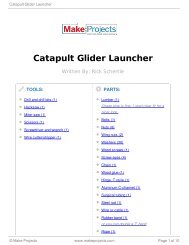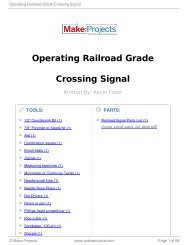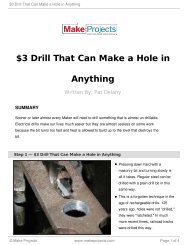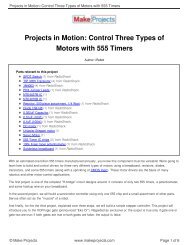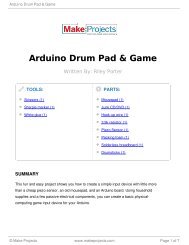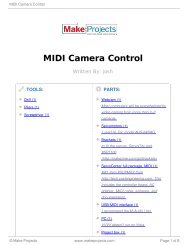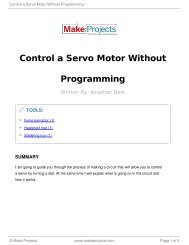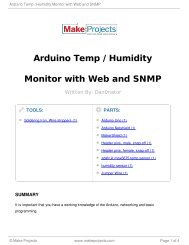Create successful ePaper yourself
Turn your PDF publications into a flip-book with our unique Google optimized e-Paper software.
<strong>Build</strong> a <strong>Pan</strong>-<strong>and</strong>-<strong>Tilt</strong> <strong>Head</strong> <strong>for</strong> <strong>your</strong> <strong>TurtleBot</strong><br />
<strong>Build</strong> a <strong>Pan</strong>-<strong>and</strong>-<strong>Tilt</strong> <strong>Head</strong> <strong>for</strong><br />
TOOLS:<br />
5/32" drill bit (1)<br />
Screwdriver, small, Phillips (1)<br />
T10 Torx wrench (1)<br />
SUMMARY<br />
<strong>your</strong> <strong>TurtleBot</strong><br />
Written By: Pi Robot<br />
PARTS:<br />
<strong>TurtleBot</strong> <strong>Head</strong> Base Plate (1)<br />
F3 Bioloid Bracket (1)<br />
F4 Bioloid Bracket (1)<br />
F10 Bioloid Bracket (1)<br />
Unthreaded Spacers Female (2)<br />
Machine screws, 4-40 (2)<br />
Machine screws, 4-40 (4)<br />
Custom Kinect mounting plate (1)<br />
Dynamixel AX-12A (2)<br />
6-32x5/8" BHCS (4)<br />
Bioloid 180mm 3 Pin Cable (1)<br />
The <strong>TurtleBot</strong> mobile robot is designed <strong>for</strong> both academic <strong>and</strong> hobbyist researchers. The<br />
open-source hardware design provides excellent documentation <strong>for</strong> adding modifications <strong>and</strong><br />
© Make Projects www.makeprojects.com Page 1 of 9
<strong>Build</strong> a <strong>Pan</strong>-<strong>and</strong>-<strong>Tilt</strong> <strong>Head</strong> <strong>for</strong> <strong>your</strong> <strong>TurtleBot</strong><br />
extending the capabilities of the robot in hardware or software. The robot is available <strong>for</strong><br />
purchase as a kit or, if <strong>your</strong> research budget is limited, this guide will help you turn <strong>your</strong><br />
<strong>TurtleBot</strong>'s Kinect into a pan-<strong>and</strong>-tilt head.<br />
Step 1 — Assemble the Base Plate <strong>and</strong> <strong>Pan</strong> Servo<br />
Step 2<br />
You will need:<br />
1x Printed/Lasercut Base Plate<br />
1x F3 Bioloid Bracket<br />
1x Dynamixel AX12A<br />
4x Bioloid N1 (M2 Nut)<br />
4x Bioloid S1 (M2-6 Screw)<br />
4x Bioloid S2 (M2-8 Screw)<br />
Put nuts (N1) in the bottom two<br />
holes of the servo on either side.<br />
© Make Projects www.makeprojects.com Page 2 of 9
<strong>Build</strong> a <strong>Pan</strong>-<strong>and</strong>-<strong>Tilt</strong> <strong>Head</strong> <strong>for</strong> <strong>your</strong> <strong>TurtleBot</strong><br />
Step 3<br />
NOTE ABOUT NUTS:<br />
There is a special technique to getting the nuts into the servos <strong>and</strong> to stay:<br />
First, push the nut in by h<strong>and</strong>.<br />
Next, take a screwdriver <strong>and</strong> <strong>for</strong>ce it closer into the servo.<br />
This will make the nut line up with the hole as shown in the last frame below, allowing<br />
you to screw into the nut.<br />
We will be using this technique throughout the assembly process: to put it briefly, any<br />
time th<br />
© Make Projects www.makeprojects.com Page 3 of 9
<strong>Build</strong> a <strong>Pan</strong>-<strong>and</strong>-<strong>Tilt</strong> <strong>Head</strong> <strong>for</strong> <strong>your</strong> <strong>TurtleBot</strong><br />
Step 4<br />
Aligning the servo horn<br />
Step 5<br />
The image on the left with the two red circles illustrates a case where the servo horn is<br />
not aligned with the mark on the servo body.<br />
Rotate the servo horn with <strong>your</strong> fingers to bring the two marks into alignment.<br />
The image on the right with the single green circle shows when the servo horn is aligned<br />
correctly.<br />
Insert the servo in the base in the<br />
only orientation it will fit.<br />
Turn the base around <strong>and</strong> put S2<br />
screws into the corresponding 4<br />
holes in the base plate, as shown<br />
on the right.<br />
© Make Projects www.makeprojects.com Page 4 of 9
<strong>Build</strong> a <strong>Pan</strong>-<strong>and</strong>-<strong>Tilt</strong> <strong>Head</strong> <strong>for</strong> <strong>your</strong> <strong>TurtleBot</strong><br />
Step 6<br />
Step 7 — Assemble the <strong>Tilt</strong> Bracket Components<br />
Attach an F3 bracket to the servo<br />
horn with 4 S1 screws as shown.<br />
Now you can turn the bracket along<br />
with the servo horn.<br />
Parts Needed:<br />
4x Bioloid S4 screws<br />
4x Bioloid N1 (M2 Nut)<br />
1x F4 Bioloid Bracket; 1 x F10<br />
Bioloid Bracket<br />
2 x 4-40 bolts 2"; 4 x 4-40 bolts<br />
1/2"; 2 x spacers 1 5/16"<br />
1 x Laser Cut Kinect mounting<br />
© Make Projects www.makeprojects.com Page 5 of 9<br />
plate
<strong>Build</strong> a <strong>Pan</strong>-<strong>and</strong>-<strong>Tilt</strong> <strong>Head</strong> <strong>for</strong> <strong>your</strong> <strong>TurtleBot</strong><br />
Step 8 — Prepare the Kinect Mounting Plate<br />
Carefully create a shallow countersink <strong>for</strong> each of the 4 inner screw holes on the Kinect<br />
mounting plate using a 5/32 drill bit on VERY SLOW speed or a Dremel tool.<br />
Be sure to make the countersink just deep enough so that the heads of the S4 bolts are<br />
flush with the plate's surface. The picture on the right shows the desired result.<br />
Step 9 — Attach the <strong>Tilt</strong> Bracket to the Kinect Mounting Plate<br />
Slide the 4 S4 screws through the mounting plate, the F10 bracket <strong>and</strong> the top of the F4<br />
bracket.<br />
Secure using 4 N1 nuts. It is also recommended to use some blue thread locker on these<br />
connections since they will be difficult to access later if they loosen.<br />
© Make Projects www.makeprojects.com Page 6 of 9
<strong>Build</strong> a <strong>Pan</strong>-<strong>and</strong>-<strong>Tilt</strong> <strong>Head</strong> <strong>for</strong> <strong>your</strong> <strong>TurtleBot</strong><br />
Step 10 — Prepare the Kinect <strong>for</strong> Mounting<br />
Pry off the protective grill on the bottom of the Kinect using a flat head screw driver.<br />
Remove the 2 inner security screws (then ones nearest the swivel base) using the T10<br />
Torx wrench (included in the Turtlebot kit).<br />
Step 11<br />
Use one of the security screws removed in the previous step to thread the 4 holes on the<br />
underside of the Kinect's base.<br />
Using a Phillips screw driver <strong>and</strong> the 4 1/2" 4-40 bolts, attach the mounting bracket <strong>and</strong> F4<br />
bracket assembly to the base of the Kinect in the orientation shown in the photo.<br />
Tighten the 1/2" bolts until snug but DO NOT OVERTIGHTEN as this could strip the plastic<br />
threading.<br />
© Make Projects www.makeprojects.com Page 7 of 9
<strong>Build</strong> a <strong>Pan</strong>-<strong>and</strong>-<strong>Tilt</strong> <strong>Head</strong> <strong>for</strong> <strong>your</strong> <strong>TurtleBot</strong><br />
Step 12<br />
Insert the 2" 4-40 bolts through the remaining 2 holes in the mounting plate, pass them<br />
through the spacers, <strong>and</strong> screw them into the holes where the security screws used to be.<br />
Tighten the 2 bolts until snug but DO NOT OVERTIGHTEN or you may strip the threads<br />
inside the security holes inside the Kinect.<br />
Step 13 — Connect the <strong>Pan</strong> <strong>and</strong> <strong>Tilt</strong> Assemblies Together<br />
Install 4 N1 nuts on the bottom of the tilt servo.<br />
Align the servo horn the same way you did <strong>for</strong> the pan servo.<br />
Connect the tilt servo to the F4 bracket.<br />
Connect the base of the tilt servo to the F10 bracket on the pan servo.<br />
© Make Projects www.makeprojects.com Page 8 of 9
<strong>Build</strong> a <strong>Pan</strong>-<strong>and</strong>-<strong>Tilt</strong> <strong>Head</strong> <strong>for</strong> <strong>your</strong> <strong>TurtleBot</strong><br />
Step 14 — Cable the Servos <strong>and</strong> Add St<strong>and</strong>offs<br />
Use a Bioloid 180 mm 3-pin cable to connect the 2 servos.<br />
Attach 4 st<strong>and</strong>offs, at least 1.5" long, to the 4 holes on the pan servo plat<strong>for</strong>m.<br />
The pan-<strong>and</strong>-tilt head is now ready to be mounted to <strong>your</strong> <strong>TurtleBot</strong>.<br />
This document was last generated on 2012-11-03 05:48:54 AM.<br />
© Make Projects www.makeprojects.com Page 9 of 9




